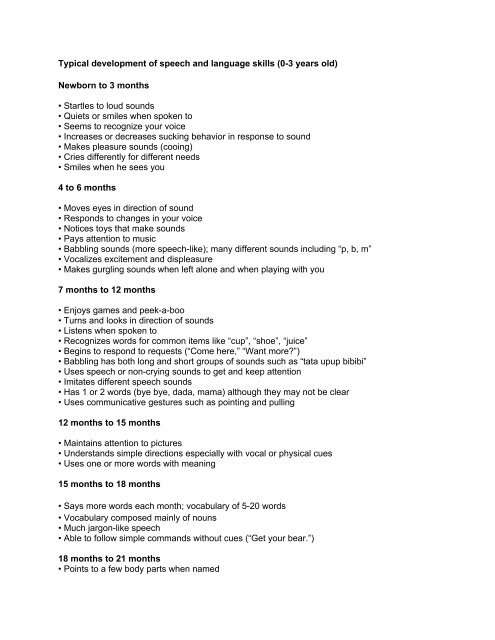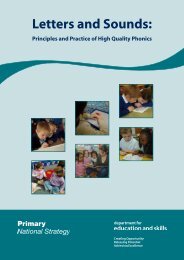Typical development of speech and language skills (0-3 years old ...
Typical development of speech and language skills (0-3 years old ...
Typical development of speech and language skills (0-3 years old ...
Create successful ePaper yourself
Turn your PDF publications into a flip-book with our unique Google optimized e-Paper software.
<strong>Typical</strong> <strong>development</strong> <strong>of</strong> <strong>speech</strong> <strong>and</strong> <strong>language</strong> <strong>skills</strong> (0-3 <strong>years</strong> <strong>old</strong>)<br />
Newborn to 3 months<br />
• Startles to loud sounds<br />
• Quiets or smiles when spoken to<br />
• Seems to recognize your voice<br />
• Increases or decreases sucking behavior in response to sound<br />
• Makes pleasure sounds (cooing)<br />
• Cries differently for different needs<br />
• Smiles when he sees you<br />
4 to 6 months<br />
• Moves eyes in direction <strong>of</strong> sound<br />
• Responds to changes in your voice<br />
• Notices toys that make sounds<br />
• Pays attention to music<br />
• Babbling sounds (more <strong>speech</strong>-like); many different sounds including “p, b, m”<br />
• Vocalizes excitement <strong>and</strong> displeasure<br />
• Makes gurgling sounds when left alone <strong>and</strong> when playing with you<br />
7 months to 12 months<br />
• Enjoys games <strong>and</strong> peek-a-boo<br />
• Turns <strong>and</strong> looks in direction <strong>of</strong> sounds<br />
• Listens when spoken to<br />
• Recognizes words for common items like “cup”, “shoe”, “juice”<br />
• Begins to respond to requests (“Come here,” “Want more?”)<br />
• Babbling has both long <strong>and</strong> short groups <strong>of</strong> sounds such as “tata upup bibibi”<br />
• Uses <strong>speech</strong> or non-crying sounds to get <strong>and</strong> keep attention<br />
• Imitates different <strong>speech</strong> sounds<br />
• Has 1 or 2 words (bye bye, dada, mama) although they may not be clear<br />
• Uses communicative gestures such as pointing <strong>and</strong> pulling<br />
12 months to 15 months<br />
• Maintains attention to pictures<br />
• Underst<strong>and</strong>s simple directions especially with vocal or physical cues<br />
• Uses one or more words with meaning<br />
15 months to 18 months<br />
• Says more words each month; vocabulary <strong>of</strong> 5-20 words<br />
• Vocabulary composed mainly <strong>of</strong> nouns<br />
• Much jargon-like <strong>speech</strong><br />
• Able to follow simple comm<strong>and</strong>s without cues (“Get your bear.”)<br />
18 months to 21 months<br />
• Points to a few body parts when named
• Follows simple comm<strong>and</strong>s <strong>and</strong> underst<strong>and</strong>s simple questions (“Roll the ball,”<br />
“Where’s your shoe?”)<br />
• Listens to simple stories, songs, <strong>and</strong> rhymes<br />
• Points to pictures in a book when named<br />
• Uses many different consonant sounds at beginning <strong>of</strong> words<br />
• Expressive vocabulary <strong>of</strong> 25-50 words<br />
• Uses some 1-2 word questions (“What’s that?” “Daddy?” “Bye bye?”)<br />
• Puts 2 words together (“more cookie”, “no juice”, “Mommy book”)<br />
• Language explosion around 18-24 months; vocabulary <strong>of</strong> 150-300 words by<br />
24 months<br />
24 months to 36 months<br />
• Underst<strong>and</strong>s differences in meanings <strong>of</strong> words (in/out, go/stop, up/down)<br />
• Follows two requests (“Get the book <strong>and</strong> put it on the table”)<br />
• Has a word for almost everything<br />
• Uses 2-3 words to talk about <strong>and</strong> ask for things<br />
• Speech is understood by familiar listeners most <strong>of</strong> the time<br />
• Often asks for or directs attention to objects by naming them<br />
36 months<br />
• Hears you when you call from another room<br />
• Answers simple “who?,” “what?,” “where?,” “why?” questions<br />
• Talks about activities at school or friend’s home<br />
• People outside family usually underst<strong>and</strong> child’s <strong>speech</strong><br />
• Uses a lot <strong>of</strong> sentences that have 4 or more words<br />
Adapted from: http://www.childrensmemorial.org/documents/SpeechLangDevellMilest.pdf
















